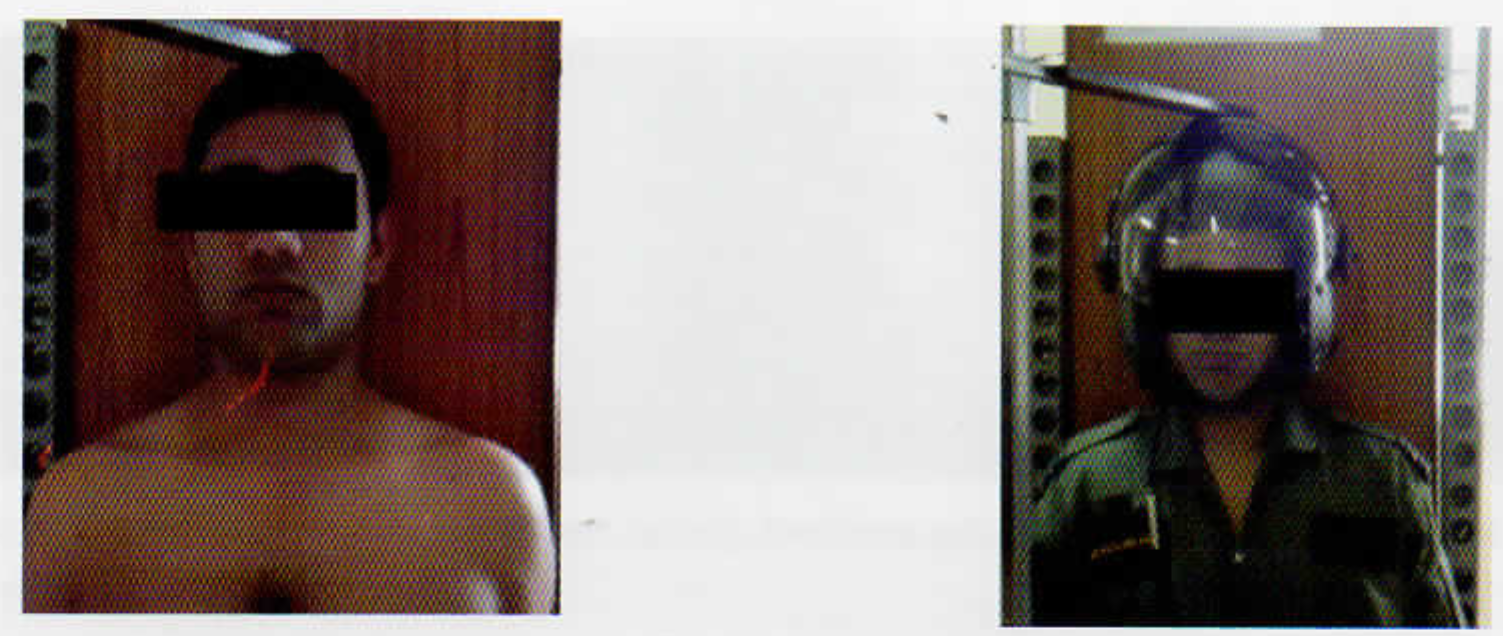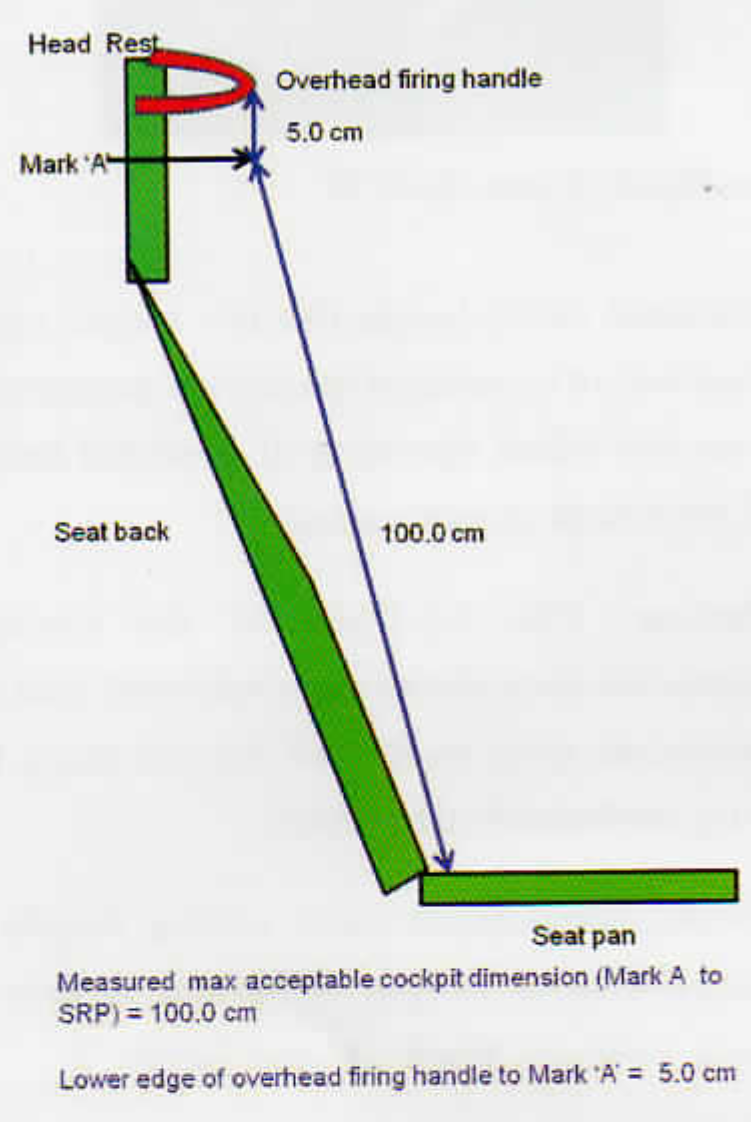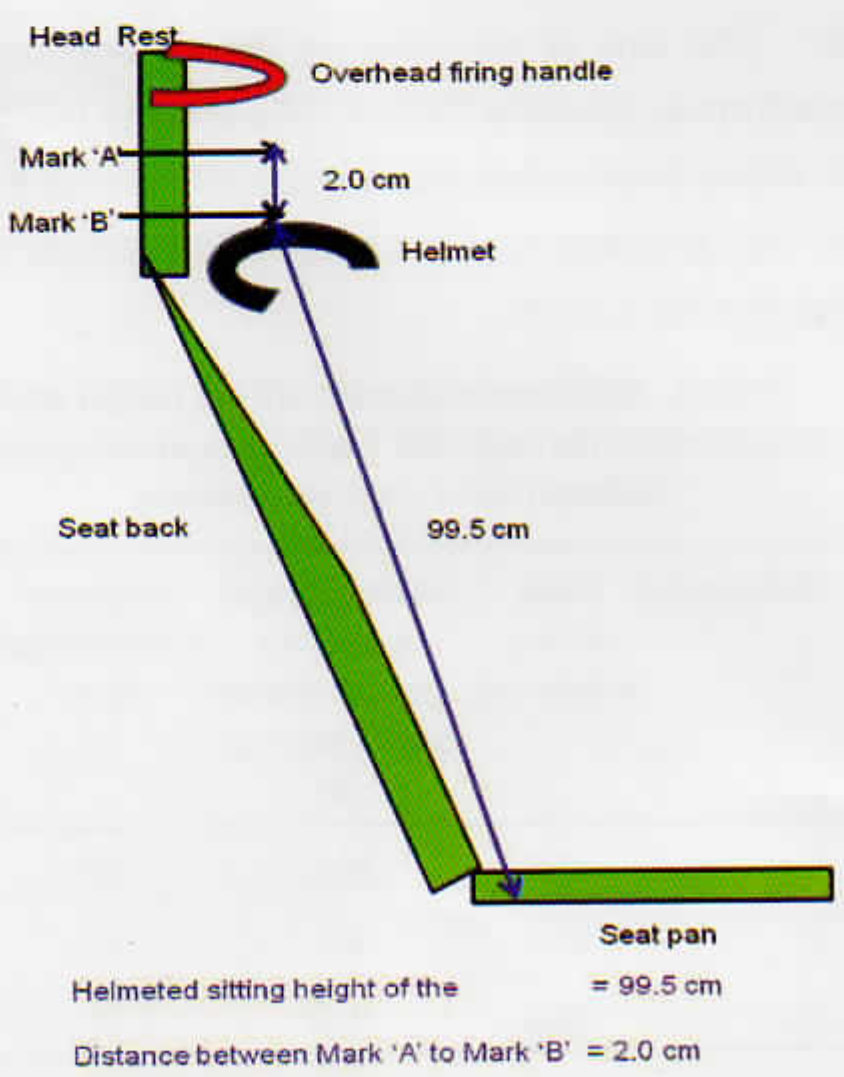Translate this page into:
Maximum Permissible Sitting Height with the Induction of A New Helmet: A Critical Analysis
Abstract
Light weight integrated helmets (LWIH) have recently replaced the older ABEU helmets in Indian Basic Jet Trainer aircraft. The present study was thus conducted to determine the maximum permissible sitting height in this aircraft with the aircrew wearing LWIH. This study was conducted in three parts. The first part was to study the relationship between the nude sitting height and helmeted sitting height on the anthropometry platform. This was required to translate nude sitting height measured on the anthropometry platform to the actual in-flight condition wherein a helmet is worn. The second part of the study was to assess the ejection seat compressibility factor to differentiate between the nude sitting height measured on a rigid anthropometry platform vis-a-vis use of recommended ejection seat cushion used in the aircraft. The final part of the study was to determine the max sitting height with a fully kitted tall aircrew in the static aircraft after giving the correction factors determined above to translate the in-flight observations in terms of the nude sitting height. The helmeted sitting height was 5 cm more than the nude sitting height for LWIH with the outer visor up position. The seat compressibility was found to be 1.5 cm. Based on the cockpit trial of the subject, the max compatible nude sitting height with LWIH helmet was found to be 96.5 cm. Aircrew with nude sitting height of 96.5-97.5 cm are recommended to undergo cockpit trial for clearance.
Keywords
Nude Sitting Height
LWIH. Ejection Seal Compressibility
Aircrew-Aircraft Compatibility
Introduction
The maximum permissible sitting height in the Indian Basic Jet Trainer aircraft is laid down as 96.5 cm and 98.5 cm for aircrew using Mk I and Mk II ABEU helmets respectively [1]. Recently, newer helmets called the Light Weight Integrated Helmets (LWIH) have replaced the ABEU helmets for the aircraft. The present study was thus conducted to determine lite maximum permissible sitting height in the above aircraft with die aircrew wearing LWIH.
Trial Preconditions
The conduct of the present trial was based on the following important trial pre-conditions:-
The Basic Jet Trainer aircraft is equipped with Martin Baker (MB) Mk IV ejection seat, which has an additional overhead firing handle [2]. The maximum permissible sifting height is hence limited in this aircraft by the ability of the aircrew to optimally operate the overhead firing handle. This is different from other modem aircraft that do not have overhead firing handle and in which the clearance from the canopy determines the maximum permissible sitting height.
The optimal position of the helmeted head which would ensure optimal operation of over head firing handle has not been marked on the seat.
The MB Mk IV seat has up-down adjustment that is slotted for six positions unlike the continuous motored adjustment capability of the modern ejection seats [3]. The total up-down adjustment is 6 inches. Due to this slotted adjustment, subjects within one inch difference in sitting height would prefer the same slot.
The cushion provided with the MB Mk IV seat is compressible. The compressibility of the seat cushion needs to be factored in while determining the maximum compatible sitting height.
The LWI helmet is equipped with an inner clear visor and an outer dark visor. At any given time one visor will always be in ‘up’ position (clear visor in day and dark visor at night). Outer dark visor in ‘up’ position at night is the worst case clearance scenario in so far as operation of overhead firing handle is concerned. Hence subject trials were required to be done with outer visor in ‘up’ position.
The extrapolation of maximum compatible nude sitting height from the trial would need to be confirmed with physical measurement of nude sitting height with helmeted sitting height (with outer visor in ‘up position) in the laboratory on the anthropometry platform.
Methodology
The trial was conducted by a team of two Aviation Medicine Specialists and three Qualified Flying Instructors (QFIs). The trial methodology is divided in the following three broad parts:-
Study of relationship between nude sitting height and helmeted sitting height: Three non-aircrew subjects were selected and their erect sitting height was recorded on the anthropometry platform in the conventional way [4]. The fully kitted subjects then donned a snugly fitting LWI helmet. The outer visor of this helmet was kept in ‘up’ position and the erect sitting height was once again recorded (Figure 1)

- Measurement of nude Sitting Height and LWIH Helmet
Study of ejection seat cushion compressibility factor: The seat pan with the cushion was placed on a hard surface in the ejection seat bay. A light wooden platform fitting on to the shape of the seat was placed on the top of the seat. The height of the seat was measured. A tall subject (nude sitting height of 94.5 cm) was made to sit on the seat. The height of the seat was again measured as shown in Figure 2. The differences in the height of the seat with and without subject revealed the seat compressibility factor.

- Height of seat cushion in Ki ran Mk I showing compressibility
Trials on Static aircraft: The ideal sitting position in the aircraft was determined by the QFls keeping in mind the ability to grasp and operate overhead firing handle. The three QFIs on type independently determined the ideal head position vis-a-vis the overhead firing handle. For this purpose a fully kitted subject wearing the LWIH was made to sit in the cockpit. The subject was made to sit erect on the seat adjusted to uppermost position. Outer dark visor was kept in up position. The seat was gradually moved down from the uppermost adjustment slot to the next lower slot. At each of these six seat positions, the ability to reach and grasp overhead firing handle, apply full rudder throw and ability to achieve operational visual requirement was assessed. In the third slot from the top the given subject had the most optimal grip of the overhead firing handle. The subject was asked to stretch upward while grasping the overhead firing handle to see how far more ‘up’ he could be whilst maintaining a good grip on the overhead firing handle. The subject could easily push himself up since there was no compulsion of him keeping the feet on the rudder pedal as in actual flight. The highest point beyond which the subject started flexing his neck to still grasp the overhead firing handle was identified as shown in Figure 3.

- Ideal sitting position for operating overhead ejection handle and Mark‘A’on the Seat Headrest
The optimal helmeted head position was marked on the seat headrest as Mark ‘A’. This was achieved with the help of a horizontal scale placed on the top of helmeted head with the subject sitting at optimal head position and marking this point on the headrest (Mark A in Figure 3). The distance between this point and the lower edge of the overhead firing handle was measured. The seat was then adjusted to the lowermost position. A horizontal scale was placed at mark 'A' on the headrest. Then the vertical distance between that point on the horizontal scale where most protruding part of the visor was present to the seat reference point was measured.
Calculations
Cockpit measurements: The cockpit measurements needed to fulfill the following mathematical equation:-
| Measured max acceptable cockpit dimension (Mark A to SRP) | = | Maximum permissible nude sitting height + helmet height |
| Thus, Max permissible nude sitting height | = | [Measured max acceptable cockpit dimension (Mark A to SRP) - helmet height |
The helmet height is known from data collated on the anthropometry platform. Similarly seat compressibility factor is known from measurements done in the ejection seat bay. Filling these values and the measured max acceptable cockpit dimension (Mark A to SRP), the maximum permissible nude sitting height was calculated.
Measurements with a tall subject: A tall subject (nude sitting height of 94.5 cm and helmeted sitting height with LWIH with the dark visor in up position of 99.5 cm) fully kitted with flying clothing and wearing LWI helmet (with the outer dark visor in ‘up’ position) was made to sit erect on the ejection seat. The seat was placed in the lowermost adjustment slot as was expected in a tall subject. Unlike in the subject used in the determination of ideal sitting position vis - à - vis overhead firing handle in the cockpit where ability to operate the overhead firing handle was the only criteria considered, the correctness of this subject’s sitting position was determined by the ability to reach overhead firing handle, ability to operate rudder pedal in its full range (for the sake of spin recovery) after adjusting the rudder pedals to the leg length and optimal over the nose outside vision.
With the subject sitting erect, his actual helmeted head position was marked on the headrest by means of a horizontal scale placed on the top of helmet (Figure 4). This point was marked as ‘Mark B’. The distance between mark ‘A’ and ‘B’ was measured by a scale. This difference represents the additional sitting height that this subject could have had before he reached the highest permissible point beyond which operation of overhead handle would have been compromised.

- Measurement of distance between Mark 'A'and Mark “B’
Validation: The findings of the cockpit measurements done above were validated with the measurements done in the tall subject using the following mathematical equation:-
Maximum permissible nude sitting height = Helmeted sitting height - helmet height + Distance between Mark ‘A ’ and Mark B
| Subject No | Nude sitting height (a) | Sitting height with LWI helmet (outer dark visor up) (b) | Height of LWI helmet(b-a) |
|---|---|---|---|
| 1 | 83.6 | 88.6 | 5.0 |
| 2 | 91.1 | 96.2 | 5.1 |
| 3 | 92.8 | 97.8 | 5 |
Results
The data of recording on the anthropometry platform is shown in Table 1. The average increase in sitting height while wearing LWIH with the visor in ‘up’ position vis- à-vis nude sitting height was noted to be 5.0 cm.
The seat cushion compressibility was found to be 1.5 cm.
The cockpit measurements are shown diagrammatically in Figure 5. The measured max acceptable cockpit dimension (Mark A to SRP) was found to be 100.0 cm.
The distance between Mark ‘A’ and Mark ‘B’ was found to be 2.0 cm (Figure 6). In accordance with above, the Maximum permissible nude sitting height = 100.0 + 1.5 - 5.0 = 96.5 cm
The tall subject’s helmeted sitting height was found to be 99.5 cm. The maximum permissible nude sitting height was thus calculated to be (99.5 - 5.0+ 2.0) cm = 96.5 cm.

- Cockpit measurements

- Measurement in tall percentile subject
Discussion
The maximum permissible nude sitting height compatible with the aircraft with the aircrew wearing LWIH was found to be 96.5 cm both by cockpit measurements and subject trial using a tall subject. The key factor which determined the maximum sitting height in such aircraft fitted with an ejection seat having an additional over the head firing handle was the ability to grasp and operate the overhead firing handle instead of the conventional over the head canopy clearance.
During the trials, the SOP for initiation of ejection handle was envisaged and it was understood that seat pan handle is the primary firing handle to initiate ejection. Hence theoretically, it can be argued that if the seat pan firing handle is fail proof, there is really no need to have additional overhead firing handle as indeed has been done in later versions of all ejection seats world-over including Martin Baker. The removal of this handle would remove the restriction imposed by the physical obstruction of the helmeted head. Conjecturally this would provide a very large clearance directly from the canopy that would permit unlimited nude sitting height compatibility subject to have optimal vision and rudder pedal usage. It is however, reiterated that any such modification needs careful scrutiny form operational perspective and most importantly requires inputs form the ejection seat OEM.
The ideal distance between the overhead firing handle and optimal helmeted head position (Mark ‘A’) was subjectively determined. Moreover, the anthropometry of the fist may vary from subject to subject. It is hence possible that subjects with nude sitting height marginally higher than 96.5 cm may also be compatible. It is hence recommended that subjects with nude sitting height between 96.5 to 97.5 cm undergo cockpit trials in presence of QFI and Aviation Medicine Specialist to determine compatibility.
References
- Manual of medical examinations and medical boards - IAP 4303 (3rd edition). New Delhi: Air Headquarters; 2003.
- [Google Scholar]
- History and development of Martin-Baker Escape Systems. Available at www.History_Development-of_MBA.pdf
- [Google Scholar]
- Maintenance Manual MB Mk-IV ejection seat. Bangalore, India: Hindustan Aeronautics Limited; 1989.
- [Google Scholar]
- Specific anthropometric measurements for indigenous aircraft design: Formulation and development of field qualified measurement techniques and computerized data management. In: AFMRC Report. Vol 89. 1767.
- [Google Scholar]






